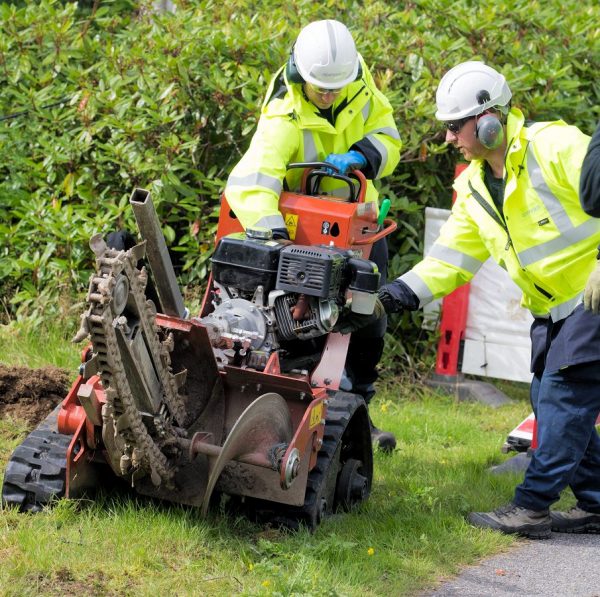Openreach Updates on Rural FTTP Pilot Progress in Okehampton

Last autumn Openreach (BT) revealed that the West Devon (England) town of Okehampton would be among 13 other rural locations to help pilot a “range of new tools and techniques” for deploying their 1Gbps Fibre-to-the-Premises (FTTP) broadband ISP network (here). Fast forward to today and the work is almost completed.
The pilots were designed to test a number of innovations, such as remote FTTP nodes (Mini OLT) in street cabinets, the ditch witch cutter (pictured), micro ducting, ground penetrating radar, diamond cutters (trench digging), mobile planning (Orion) and a GeoRipper (used for digging trenches across soft ground at pace) etc. All together these improvements could help to speed up the roll-out and cut deployment costs.
Since then the operator has expanded their rural roll-out plan to include several hundred additional villages and towns in harder to reach areas (here, here and here). Assuming all goes to plan then some 3.2 million premises under their commercial deployment are expected to be in rural locations by 2025/26.
Advertisement
The town of Okehampton was one of the first to pilot these new innovations and, despite only being announced last October 2019, Openreach has already extended their local FTTP network to cover 3,000 premises in the area. At present the build is about 75% completed and there’s another 1,000 or so properties left to reach.
Connie Dixon, Openreach’s Regional (South West) Partnership Director, said:
“We’re making great progress here in Okehampton, and our Full Fibre build has continued despite the obvious challenges. As well as keeping people connected using our existing network, our engineers have continued building the new infrastructure to make sure that as lockdown restrictions ease, we can support families, businesses and the economic recovery.
I’d encourage everyone who can to upgrade to the new technology and take advantage of the many benefits. Full Fibre is more reliable and more resilient, meaning fewer faults and more predictable, consistent speeds. It’s also ‘future-proof’ as we expect it to easily meet the growing data demands of future technologies for decades to come. Use the fibre checker on our website to check your postcode to see if Full Fibre is available.”
Mind you it should be said that Okehampton, while challenging, is a lot easier to do today because it was one of the areas where Openreach were able to deploy “superfast broadband” (hybrid fibre FTTC / VDSL2) via state aid support under the original Connecting Devon and Somerset (CDS) contract in 2014 (here). Other locations, such as those where only ADSL or very slow FTTC still exists, will be harder.
The other 12 villages and towns named in that original pilot (covering 50,000 premises in total) were Cranfield; West Calder; Flockton; Hesketh Bank; Kentford; Lingfield; Lundin Links; Mickle Trafford; Ottery St Mary; Parbold; Seal and Tarporley. Many of those are also nearing completion of Openreach’s FTTP pilot roll-out.
Mark is a professional technology writer, IT consultant and computer engineer from Dorset (England), he also founded ISPreview in 1999 and enjoys analysing the latest telecoms and broadband developments. Find me on X (Twitter), Mastodon, Facebook, BlueSky, Threads.net and Linkedin.
« Welsh Broadband ISP Dyfed Superfast Buys Pembs WiFi for FTTP
O2 Predict 5G to Save UK up to 269 Megatonnes of CO2 by 2035 »






















































I was wondering about the 2nd to last paragraph Mark, How did the FTTC deployment under CDS help there over and above other areas that have ‘slow FTTC’ when installing FTTP ?
It really would be interesting to see what they have actually carried out, I mean how far out of the denser areas have they gone, have they been running down single track lanes to houses and farms, curious to know what they’re actually installing along these kind of routes when the properties arent clustered together to make good use of a CBT on a pole.
I know my area, much like alot of Northern Scotland is almost the worst case scenario for fttp deployment so interested to see what comes of these ‘trials’
On FTTC it depends how far away the cabinet is and how dense the community. Some rural communities live at the very edges of FTTC’s reach, so the actual DSLAM can be a long way away and thus it doesn’t help too much; especially if the community is spaced out over a wide area.
But in other communities you might have one or several cabinets internal to the village/town itself, which means less work to bring in FTTP (but in both cases reaching individual homes will still take time/cost). With ADSL of course you have no fibre, except maybe to the exchange.. however far away that is for a given location.
In Marks’s example there are many small villages where fttc cab in dead centre of a village and most properties within perhaps 100yrds of the cab. BT are rolling fttp into some of these as we speak…
“ such as remote FTTP nodes (Mini OLT) in street cabinets”
I’ve been saying for a long time that this was inevitable. Marrying existing fibre and existing power.
lost of these places in rural have neither so wont help and are normally significant distance from existing street cabinets
https://www.ispreview.co.uk/index.php/2019/09/a-look-at-openreachs-compact-fttp-broadband-ont-and-mini-olt.html
It’s called a sub tended head end, used to extend the reach of a head end in an exchange past 58km.
@Fastman
“lost of these places in rural have neither so wont help and are normally significant distance from existing street cabinets”
I assume you mean lots or did you mean the OR guys get lost round your neck of the wood?
As @Tony says that this was in the pipeline is not new news. That it is now in test/model deployments is a step further down the line.
The reason this is important is as @Tony say that it extends the 58km reach from the nearest backhaul. Getting out to ultra remote: that 58km limit is an issue. Further, it is an issue if you need to run fresh fibre out to where there is a DSLAM. And now piggybacking arrangements are now viable so the money and effort is spent building FTTP outwards and not putting more duplicated backhaul in the ground.
It is all good news for faster and cheaper FTTP deployments.
Just how many properties are more than 58km (36 miles) from an exchange? Apart from the remotest parts of Scotland I find it hard to believe there are many at all.
@AnotherTim
The issue is the aggregated length of the Fibre including the PON.
lines don’t run straight and a lot double back on themselves.
So you might run to another village from the existing DSLAM and then double back to another village as that is the way the existing poles run.
It needs a lot of doubling back to use up 36 miles. What you are basically saying is that it is more cost effective to develop a new technology and build several times as much fibre as necessary in order to reach the last fraction of a % of properties, than it is to put in a few new poles to straighten the network?
Not all exchanges have the OLT’s, some are fed from a larger exchange elsewhere and routed through your local exchange to the cabinets. So a cabinet may belong to one exchange in a small town or village, but be fed from a head end in another town or village 10/15/20 miles away. Don’t forget, it’s not as the crow flies either so routes may also be longer than you think.
Big lolz at everything getting heated up arguing about 58km.
The mini OLT are not just about extending distance the GPON can run
” than it is to put in a few new poles to straighten the network?”
Hardly a few – to transform the network to fit todays best routes would be a simply vast job…